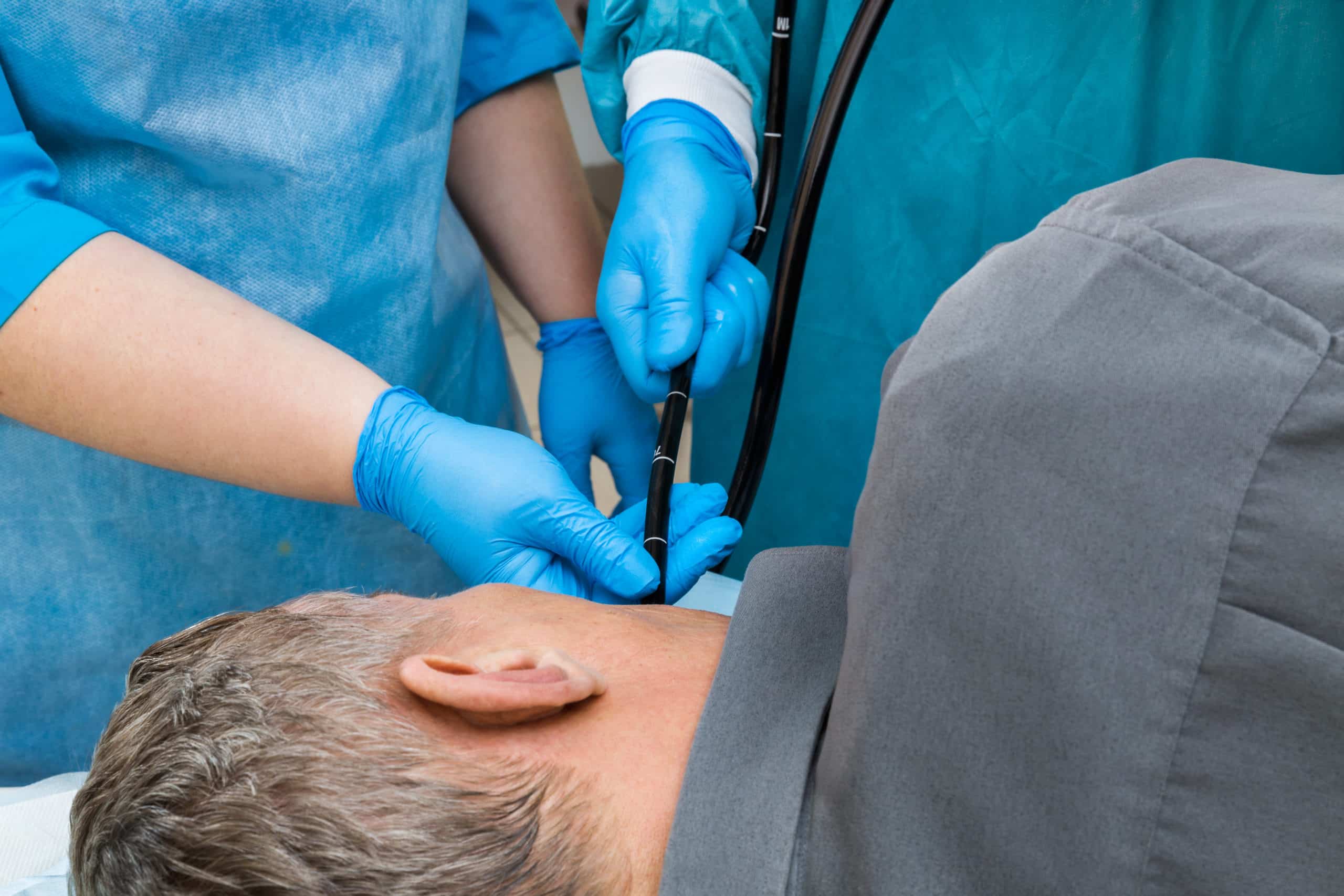If a suspicious lesion is found in the throat, a doctor may perform a biopsy to determine whether or not the lesion is cancerous. The throat includes the oropharynx, hypopharynx, larynx, and cervical esophagus. Usually, a doctor will perform an endoscopy along with a biopsy. Below you will find descriptions of different throat or esophageal biopsy methods.
Transnasal Flexible Endoscopy
This method has the advantage of being able to be performed while the patient is awake in the office. The doctor may spray the nose with some decongestant and numbing medications. A small flexible camera will then be slowly and carefully passed through the nose and directed down towards the throat to visualize the suspicious lesion. During this type of biopsy, it is important for patients to sit still, breathe slowly and listen to the doctor’s instructions. The camera used in this case has a special channel through which the doctor can spray medicine directly onto the area of interest to numb it. Through that same channel, the doctor can pass thin biopsy forceps and remove a tiny piece of tissue from the suspicious lesion.
Advantages & Disadvantages
The main advantage of transnasal flexible endoscopy is that it is usually quick and easy, and it does not require going to the operating room and undergoing general anesthesia. However, the doctor can only get a tiny piece of tissue this way, and it might not lead to the correct diagnosis. Finally, the doctor is often unable to get as good a look as with a direct laryngoscopy.
Direct Laryngoscopy with Rigid Hypopharyngoscopy or Esophagoscopy
This technique, performed by a surgeon, might be chosen if the doctor can’t get a good biopsy in the office or wants to get a better look around the patient’s throat in the operating room. The doctor might either take a small biopsy of the suspicious lesion in the operating room to confirm the diagnosis, or sometimes simply remove the entire mass (called an excisional biopsy). For this type of biopsy, the patient will go to sleep with anesthesia in an operating room. Once the patient is fully asleep, the surgeon will place an instrument called a laryngoscope through the patient’s mouth and into the throat. The surgeon may also use a longer scope, such as a hypopharyngoscope or an esophagoscope, to look at the hypopharynx or upper part of the esophagus. The surgeon will then remove a small piece of tissue from any suspicious-looking areas using endoscopic instruments.
Advantages & Disadvantages
This method allows the doctor to thoroughly feel all around the patient’s neck, mouth and throat while he or she is asleep, looking for any additional suspicious lesions. Another advantage of this technique is that frozen section pathology is usually available in the operating room, which allows for a faster diagnosis, and helps the doctor confirm that enough tissue has been sampled from the lesion to make a definitive diagnosis.
Flexible Esophagoscopy
Flexible esophagoscopy is performed by a gastroenterologist as an outpatient procedure under moderate sedation. This is performed with a larger flexible endoscope through the mouth. It is an excellent technique for biopsying esophageal masses, especially if they are located in the mid or lower esophagus.
CT-guided Needle Biopsy
This is used quite rarely for throat and esophagus tumors. It is usually required only if the surgeon cannot get to the suspicious area despite trying the standard ways described above. CT-guided needle biopsies are typically done by an interventional radiologist. This technique is more commonly used to evaluate lesions in distant locations, such as suspicious nodules in the chest. For this type of biopsy, the patient will be placed into a CT scanner, and a few low-dose CT scans will be performed to identify where the tumor is located. A tiny injection of medicine will then be used to numb the skin. Then a small needle will be passed through the numb area toward the tumor. This may require a few additional low-dose CT scans to adjust the needle and make sure it gets to the area of interest. The radiologist may use some emerging technologies, such as fluoroscopic CT scanning, which allow the radiologist to quickly take a few scans without leaving the room, and then adjust the needle and move it into the right place.
Advantages & Disadvantages
The main advantage of this technique is that the needle can reach some areas more easily than the surgeon would be able to do through the mouth, throat or neck.
The main disadvantages are that doctor can only get a small piece of tissue, which might not lead to the correct diagnosis, and that it does not provide a direct view of the mass as with laryngoscopy in the operating room.
Transnasal Esophagoscopy with Biopsy
This technique is less common and uses a long flexible camera to look past the pharynx into the esophagus and take a small biopsy right in the office. Not all doctors have the equipment necessary for this technique and patients may have a difficult time tolerating this procedure awake.

Download This Section
Feel free to download and print this page.
It’s free for personal use and to share with others you think might benefit from the information provided.












